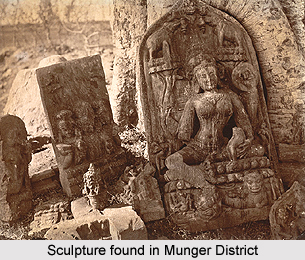 Geography of Munger District has been famous for its mineral waters and hot water springs. There is a belt of thermal springs along a zone from Kharagpur hills to Rajgir hills of Patna District. There are altogether seven groups of thermal springs in Munger District and these are Bharari (Chormara group), Bhimbandth group, Hingania group, Remeshwar-Lakshmishwar-Bhowrah Kunds groups, Rishi kund groups, Sita kund - Phillips-kund group and Sringirishi group.
Geography of Munger District has been famous for its mineral waters and hot water springs. There is a belt of thermal springs along a zone from Kharagpur hills to Rajgir hills of Patna District. There are altogether seven groups of thermal springs in Munger District and these are Bharari (Chormara group), Bhimbandth group, Hingania group, Remeshwar-Lakshmishwar-Bhowrah Kunds groups, Rishi kund groups, Sita kund - Phillips-kund group and Sringirishi group.
The northern plain of Munger District has two facets of landscape namely the north of the Gangetic levee and tal lands south of the levee. Some of the important diaras are Maheshpur, Heru, Bahadurpur, Kalarampur, Budhwa and Taufir diaras. These diaras suffer from annual inundation along with the erosion and deposition of soils. The area south of the Gangetic levee is known as Tal lands. Some of the important tals are Barhiya tal, Mainma tal, Bilya tal, Bariarour tal and others. Some of the important rivers like Kiul Harohar, Dakranal and Baduar deposit soil in their flood plains. Tal lands also suffer from annual inundation, water loggings and deposition of soil. Munger District on an average is 30 to 65 meters above sea level.
There are three district seasons in this zone namely, summer, monsoon and winter. The summer season is characterized by gradual rise in temperature, occasional thunder showers and hail storm, high velocity westerly during this season is very dry resulting in sunstroke deaths at times. The maximum temperature rises up to 45 degree Celsius. Monsoon season starts from middle of June and continues up to the end of September. Monsoon is characterized by cloudy weather, high humidity, frequent rains and weak variable surface wind. Maximum rainfall occurs during July and August. Winter season is characterized by gradual decrease in temperature which comes to a minimum in the first week of January. Thereafter, the temperature starts increasing. The minimum temperature varies from 3.5 degree Celsius to 9 degree Celsius. Rainfall under this zone is mainly influenced by the south-west monsoon which sets in the second week of June and continues up to the end of September. Sometimes cyclonic rain also occurs. The average annual rainfall of this zone is 1078.7 mm. The rainfall distribution is marked seasonal in character.
Soil of Munger district is grey to dark grey in colour, medium to heavy in texture and moderately alkaline in reaction. It cracks during summer and becomes shallow with onset of monsoon, with clay content nearly 40 percent to 50 percent throughout the profile. The soil of the region has a good fertility status.






